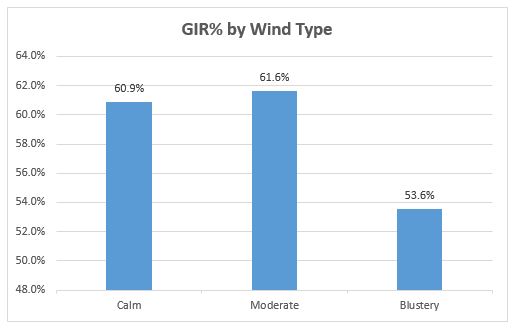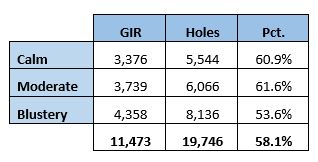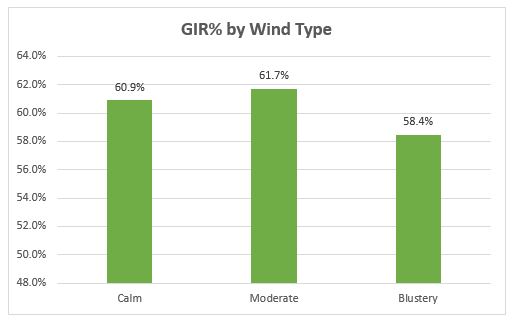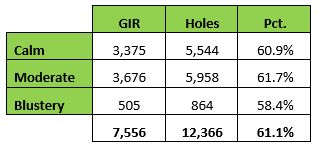It would be logical to assume that the more wind there is, the harder it would be to reach a green in regulation (GIR). But as they say, it’s an empirical question. Thankfully, we have some APBA data to look at.
Let’s begin with my entire dataset, which now consists of 19,746 holes. Here’s the GIR% broken down by wind type: Calm, Moderate, and Blustery.

As you can see, when the winds are up as on a Blustery day, the GIR% is down (53.6%) compared to Calm (60.9%) and Moderate conditions (61.6%). The difference between Calm and Moderate conditions in terms of GIR% is less than 1%, with Moderate wind being slightly more favorable.
Here are the numbers behind these percentages:

If we left it at that, you might think that Blustery winds are always a nemesis. But as it happens, a lot of the holes played under Blustery conditions were at Seaside and Yatch Club–two courses with exceptionally small greens. Seaside (Pebble Beach) has reportedly the smallest greens on the PGA TOUR at approximately 3,500 sq. ft. on average. The greens at Yatch Club (Harbour Town) average only 3,700 sq. ft., which is 30 – 40% smaller than the typical course on the tour.
None of the holes at Seaside or Yatch Club in my database was played under Calm conditions, and only 108 holes were played with Moderate wind (1.3%). Since green size alone might account for the different GIR%, I re-ran the numbers after removing all the data from those two courses.
This is what I found:

While Blustery wind still had some adverse effect on GIR%, it was much less when accounting for green size. Whereas before, the difference in GIR% between Moderate and Blustery wind was 8.1%, now it’s only 3.3%.
Here are the numbers underlying those percentages:

The number of holes played under Blustery conditions dropped by 7,272 (89.4%) when removing the ones from Seaside and Yatch Club, but we still have data on 864 holes. That’s a lot fewer than the number of holes played under Calm (5,544) and Moderate (5,958) conditions but large enough for comparison purposes.
For me, the takeaway is this: While Blustery conditions make it slightly more challenging to reach greens in regulation, the problem is magnified quite a bit when playing courses with greens that are much smaller than average.